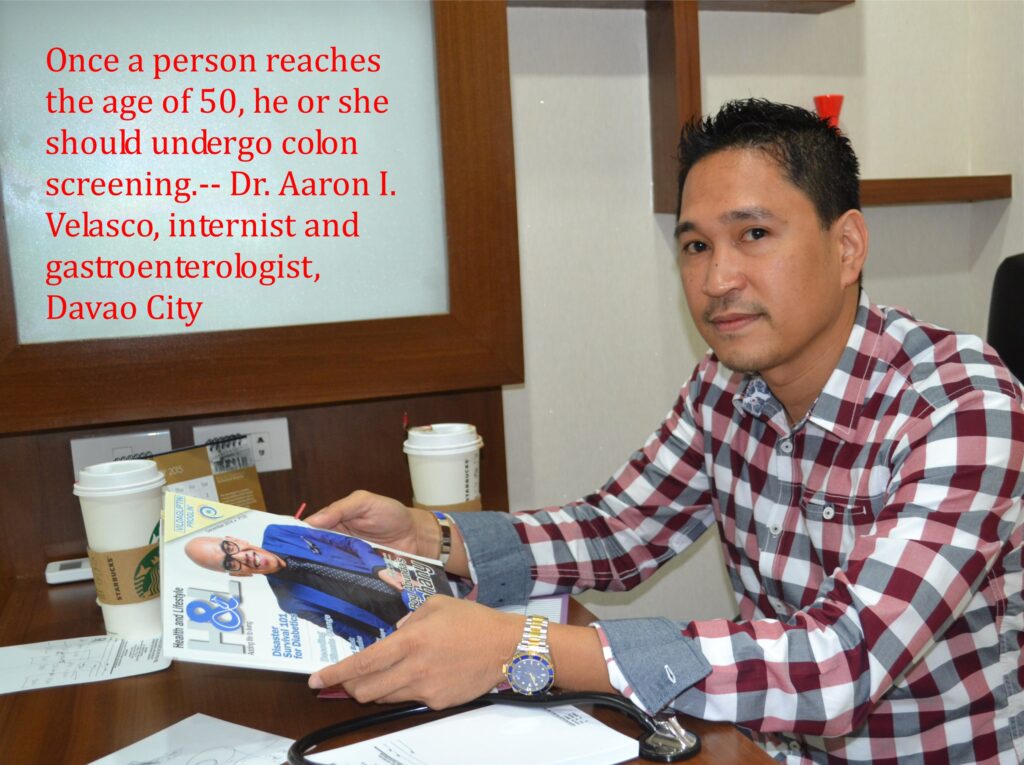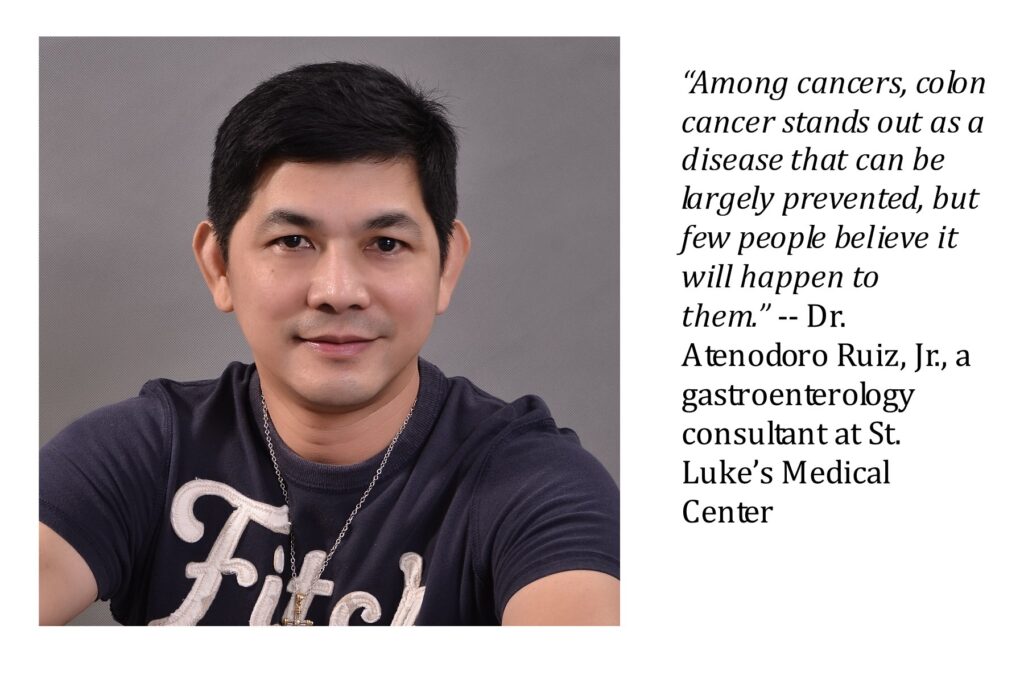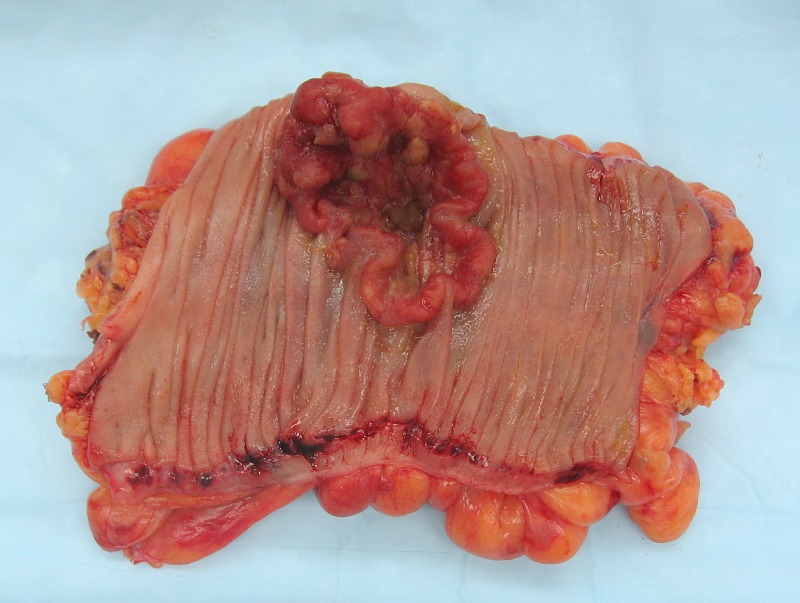Text and Photos by Henrylito D. Tacio
Featured Photo from Wikipedia
Colon cancer is the fourth most common cancer among Filipinos — after breast, lung, and liver cancers. But unlike the first three cancers, colon cancer is not commonly discussed in the open.
“Among cancers, colon cancer stands out as a disease that can be largely prevented, but few people believe it will happen to them,” said Dr. Atenodoro Ruiz, Jr., a gastroenterology consultant at St. Luke’s Medical Center and a diplomate of the American Board of Internal Medicine in Gastroenterology and the Philippine College of Physicians in Internal Medicine.
If discovered early, colon cancer is preventable and treatable. “If it is early stage and localized within the colon, the cure is 100 percent,” said Dr. Ruiz. “If it had spread to lymph nodes or distant organs, the 5-year survival rate is much lower.”
Dr. Aaron I. Velasco, an internist and gastroenterologist who works in various hospitals in Davao City, said the 5-year survival rate of those diagnosed with stage 1 colon cancer is 92%. It goes down to 63-80% for those with stage 2 and 50% with stage 3. The chance of survival of those diagnosed with stage 4 is very minimal: 11%.
One cannot talk about the colon without mention the rectum, too. Thus, colorectal cancer (CRC) came into existence. “Almost all colorectal cancers are adenocarcinomas, which develop from the lining of the large intestine and rectum,” notes The Merck Manual of Medical Information.

Dr Aaron I Velasco 
Both colon and rectal cancers begin in the digestive system, which processes food for energy, and the last part of it absorbs fluid to form solid waste (stool) that then passes from the body.
The American Cancer Society (ACS) shares this information on how the digestive system works: “After food is chewed and swallowed, it travels to the stomach. There it is partly broken down and sent to the small intestine.” The small intestine is the longest part of the digestive system – about 20 feet.
“The small intestine also breaks down the food and absorbs most of the nutrients. It leads to the large intestine (also called the large bowel or colon),” the ACS explains. “The colon absorbs water and nutrients from the food and also serves as a storage place for waste matter. The waste matter moves from the colon into the rectum, the last 6 inches of the digestive system. From there, the waste passes out of the body.”
How cancer develops
Cancer that starts in these different areas may cause different symptoms. But colorectal cancers have many things in common. “In most people, colorectal cancer develops slowly over a period of several years,” explains Dr. Gerry Cornelio, former head of the Philippine Society of Medical Oncology (PSMO).
“Colon cancer usually begins as an area of abnormal cells (lesion),” informs the Mayo Clinic in Minnesota. “Most of these abnormal lesions begin as tiny polyps — raised clumps of non-cancerous (benign) cells growing on the inner lining of the large intestine. Another type of precancerous lesion (non-polypoid lesion) forms as a flat or recessed area on the wall of the colon. Non-polypoid lesions are less common than polyps.”
According to Dr. Cornelio, if cancer forms within a polyp, “it can eventually begin to grow into the wall of the colon or rectum. When cancer cells are in the wall, they can then grow into blood vessels or lymph vessels. Once cancer cells spread into blood or lymph vessels, they can travel to distant parts of the body, such as the liver.”
Just bear this in mind, though: Not all polyps become cancerous, but nearly all colorectal cancers start out as polyps.
Until now, no one knows what causes CRC. “Epidemiologic, human case-control, and animal studies support a strong association between colon cancer and a diet that has high-fat (usually saturated fat), low fiber, and high red meat consumption,” Dr. Ruiz said.
Risk factors that predispose a person to develop colon and rectal cancer include age, personal history of adenoma or carcinoma, family history of CRC, and pre-existing diseases, like inflammatory bowel disease.
“Age 50 is the most common risk factor for CRC as 90% of cancers occur after the age of 50,” said Dr. Ruiz.
No symptoms
Like most cancers, many cases of colon cancer have no symptoms. The following symptoms, however, may indicate colon cancer: diarrhea, constipation, or other change in bowel habits; blood (either bright red or very dark) in the stool; unexplained anemia; abdominal pain and tenderness in the lower abdomen; intestinal obstruction; weight loss with no known reason; feeling very tired; and vomiting.
“The most common first symptom of rectal cancer is bleeding during a bowel movement,” says the Merck manual. “Whenever the rectum bleeds, even if the person is known to have hemorrhoids or diverticular disease, doctors must consider cancer as part of their differential diagnosis.
“Painful bowel movement and a feeling that the rectum has not been completely emptied are other symptoms of rectal cancer,” the Merck manual continues. “Sitting may be painful, but otherwise the person usually feels no pain from the cancer itself unless it spreads to tissue outside the rectum.”
As CRC doesn’t have early warning signs, it’s very important to get screened, recommends Dr. Velasco. Once the aforementioned symptoms appear, “tumors tend to be much bigger and even harder to treat.”
Understanding colonoscopy
Dr. Velasco suggests that once a person reaches the age of 50, he should undergo a colon screening. One of the highly recommended is colonoscopy, which should be done every ten years after the first screening. “In colonoscopy,” he explains, “we use a tube with a tiny camera to look at the whole colon and rectum. We don’t only find tumors early, but the test can also prevent colorectal cancer by removing polyps.”
The test usually takes 30 to 45 minutes, Dr. Velasco says. But in some instances, it may take longer, depending upon what is found and what is done during the test.
WebMd.com gives this information as to what will happen after the test: “You may have bloating or crampy gas pains and may need to pass some gas. If a biopsy was done or a polyp taken out, you may have traces of blood in your stool (feces) for a few days. If polyps were taken out, your doctor may instruct you to not take aspirin and nonsteroidal anti-inflammatory drugs for 7 to 14 days.”
Dr. Velasco cautions that there is a slight chance for problems from a colonoscopy. The scope or a small tool may tear the lining of the colon or cause bleeding. This must be the reason why WebMd.com suggests that those who undergo colonoscopy should call their doctor immediately if, after the test, they: have heavy rectal bleeding, have severe belly pain, develop a fever, are very dizzy, are vomiting, and have a swollen and firm belly.
Aside from colonoscopy, other screening tests for colon cancer include barium enema X-rays, sigmoidoscopy, stool tests, and computed tomographic colonography. Which screening test you choose depends on your risk, your preference, and your doctor. “Be sure to talk to your doctor about what puts you at risk and what test is best for you,” Dr. Velasco reminds.
As stated earlier, colon cancer is treatable when discovered early. But if cancer has already invaded other tissues, it may be too late.
On January 20, 1993, Oscar-winning actress Audrey Hepburn died of colon cancer in Tolochenaz, Vaud, Switzerland, at the age of 63. Emmy-winning American comedian and actor Milton Berle was told he had a cancerous colon tumor in 2001, but he refused surgery; he died in Los Angeles, California, the following year. Philippine President Corazon C. Aquino gave colon cancer a valiant fight before succumbing to the disease in 2009.

